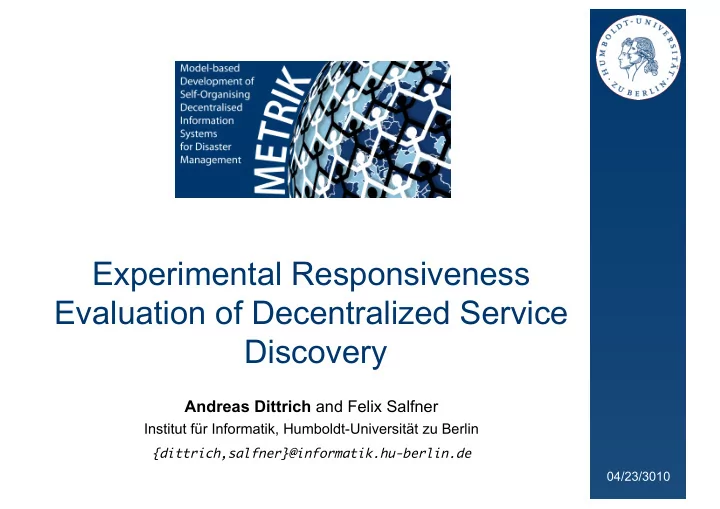

Experimental Responsiveness Evaluation of Decentralized Service Discovery Andreas Dittrich and Felix Salfner Institut für Informatik, Humboldt-Universität zu Berlin {dittrich,salfner}@informatik.hu-berlin.de 04/23/3010
Introduction April 23, 2010, DPDNS, Atlanta, USA Trends of the 21 st century Rapid convergence of computing and communication infrastructures Ubiquitous connectivity creates heterogeneous networks Internet of things Challenges Unified architecture to connect all devices and leverage their provided functionality Maintain dependability with ever-growing complexity 1
Service Networks April 23, 2010, DPDNS, Atlanta, USA Service networks approach challenges by promising to master complexity with encapsulation Service Abstract functionality, provided over the network Leveraged by using the methods of an interface on a concrete service instance providing that service in the network Service-oriented computing Defines layers of service usage Defines standardized protocols and interfaces for service networks What about dependability properties in SoC ? 2
Service Discovery April 23, 2010, DPDNS, Atlanta, USA Service Discovery Key concept in service-oriented computing Provides service instance enumeration for a given service type Provides basic service description, the mapping of instances to • network addresses, port and protocol • more specific information for service usage If a service instance cannot be discovered … Instance remains unknown and clients cannot use it Instance unavailable for the client Dependable service discovery is a prerequisite for dependable service networks 3
Service Discovery Systems Today April 23, 2010, DPDNS, Atlanta, USA Several technologies have been developed in the last decade SLP, UPnP, Jini, Zeroconf, … Technologies remain incompatible, no unified service network architecture exists Several technologies have been developed with ad-hoc scenarios in mind However, their dependability in such unreliable environments has never been proven Goal of this paper: Examine dependability of exemplary ad-hoc service network under influence of packet loss 4
Service Discovery Architectures April 23, 2010, DPDNS, Atlanta, USA Decentralized: 2-party Service provider and user All communication is done directly between provider and user Centralized: 3-party Service provider, user and registry Communication is done between provider and registry and between user and registry Adaptive Switches between 2-party and 3-party architecture under certain conditions Focus here: Decentralized service discovery using 2-party architecture 5
Service Discovery Responsiveness April 23, 2010, DPDNS, Atlanta, USA Various metrics can be used to evaluate dependability of service discovery Efficiency Latency (Update) Effectiveness Responsiveness (general) The probability of successful operation within deadlines, even in the presence of faults Responsiveness of Service Discovery The probability that a given discovery operation finishes successfully before deadline t D in the presence of faults 6
Simulation Model April 23, 2010, DPDNS, Atlanta, USA What is the probability to discover m out of n service instances within time t D in a given network with packet loss rate L ? To date, no analytical models exist to evaluate responsiveness in auto-configuring networks Today, we provide results from simulation experiments Simulation Setup Service network realized in Xen virtualized environment • Nodes run minimal Debian Linux • Avahi used for network auto-configuration and service discovery • Fully connected star topology • Up to 100 instances, number constant in each experiment • Up to 90% packet loss probability, constant in each experiment • Discovery is successful when m/n of instances have been discovered • Recovery happening on MAC and discovery layer 7
Simulation Scenarios April 23, 2010, DPDNS, Atlanta, USA Scenario 1: Find single service within deadline 1 client, 1 provider, variable packet loss, deadline t D = 10s Common scenario with lax requirements, can be considered as the baseline Scenario 2: Discover all services as fast as possible 1 client, n providers, variable packet loss Measure increase of responsiveness with time in networks with different number of service instances Scenario 3: Discover all services within deadline 1 client, n providers, variable packet loss, deadline t D = 20s Measure change of responsiveness with number of service instances in the network 8
Simulation Results – Scenario 1 April 23, 2010, DPDNS, Atlanta, USA Responsiveness of single service discovery at different rates of packet loss 9
Mastertitelformat bearbeiten Simulation Results – Scenario 2 April 23, 2010, DPDNS, Atlanta, USA Responsiveness of service discovery Responsiveness of service discovery with 20% packet loss with 40% packet loss 10
Simulation Results – Scenario 3 April 23, 2010, DPDNS, Atlanta, USA Responsiveness of multiple service discovery at different rates of packet loss 11
Conclusions April 23, 2010, DPDNS, Atlanta, USA Dependable service discovery is the precondition for a service network to operate correctly and for the services to be available. Dependability aspects of decentralized service discovery have been examined in simulated unreliable networks Simulation of three realistic scenarios Focus on responsiveness, since discovery is a time-critical operation Empirical results demonstrate Responsiveness decreases dramatically with moderate packet loss Responsiveness decreases further the more service instances need to be discovered At high packet loss rates the decrease becomes exponential with the number of nodes such that discovery becomes practically impossible Distributed service discovery has to be used with caution, especially in scenarios where packet loss cannot be neglected 12
Thank you for your attention. ? | ! 04/23/2010
Recommend
More recommend